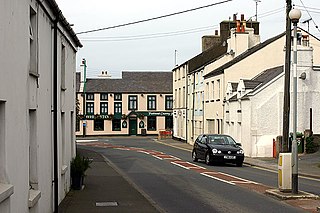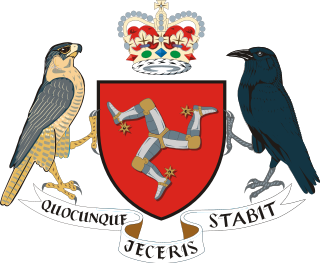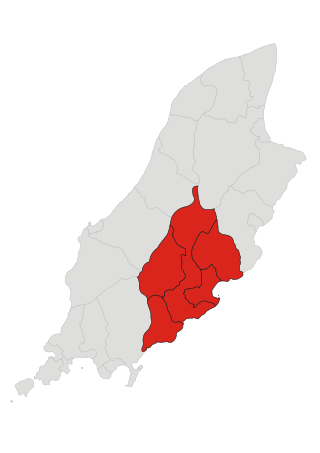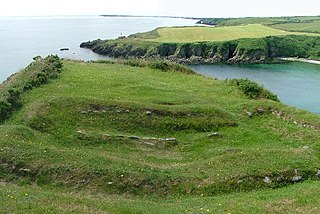
The Isle of Man is an island in the Irish Sea, between Great Britain and Ireland in Northern Europe, with a population of almost 85,000. It is a British Crown dependency. It has a small islet, the Calf of Man, to its south. It is located at 54°15′N4°30′W.

A promontory fort is a defensive structure located above a steep cliff, often only connected to the mainland by a small neck of land, thus using the topography to reduce the ramparts needed. Although their dating is problematic, most seem to date to the Iron Age. They are mainly found in Ireland, Brittany, the Orkney Islands, the Isle of Man, Devon, the Channel Islands and Cornwall.

Ballasalla is a village in the parish of Malew in the south-east of the Isle of Man. The village is situated close to the Isle of Man Airport and 2 miles (3 km) north-east of the town of Castletown.

Ballabeg is a village on the Isle of Man. It is in the parish of Arbory in the sheading of Rushen, in the south of the island near Castletown. There are several small villages and hamlets with the name, although Ballabeg in Arbory is the most well-known and populous.
Donald James Gelling CBE CP, CInstSMM is a Manx former politician, who is a former Chief Minister of the Isle of Man who served two terms as Head of the Government.

Michael is one of the six sheadings of the Isle of Man. It is located on the west of the island and consists of the three historic parishes of Ballaugh, Jurby and Michael.

Marown is one of the seventeen historic parishes of the Isle of Man. It is the only landlocked parish on the Island.

Local governmentin the Isle of Man was formerly based on six sheadings, which were divided into seventeen parishes. The island is today divided for local government purposes into town districts, village districts, parish districts, and "districts", as follows:

Rushen, formally Kirk Christ Rushen, is one of the seventeen historic parishes of the Isle of Man.

Braddan is one of the seventeen parishes of the Isle of Man.

Middle is one of the six sheadings of the Isle of Man.

Santon Burn is a watercourse in the Isle of Man.

Andreas is one of the seventeen parishes of the Isle of Man. It is located in the north of the island in the sheading of Ayre. The main settlement in the parish in the village of Andreas, which is also known as Kirk Andreas.
Saint Sanctain or Sanctan was a 6th-century Manx bishop, who originally came from Northern Britain.

Port Grenaugh is a cove in the south-east of the Isle of Man at the foot of Glen Grenaugh, in the parish of Santon, and the mouth of Grace's stream which originates in the Newtown area of the parish by Ballakissack farm.

Close to Port Grenaugh, Cronk ny Merriu is one of the remains of promontory forts in the Isle of Man. Cronk ny Merriu was previously considered by historians to be a prehistoric burial place due to its large grass-covered bank and name, literally translating to "Hill of the Dead". The bank and ditch created a defensive promontory fort at Cronk ny Merriu. Later, a rectangular building of Norse style and layout stood here, part of a system of coastal lookout posts used to protect the coastline and to police beach markets. Excavations of Cronk ny Merriu show that there was very little domestic activity, and that the Norse building likely didn't have permanent residency. It's suggested that the longhouse was primarily a building for those at nearby forts to shelter from harsh weather, rather than a place of defence itself. Although no scientific dating has been done, due to the similarities with fortified headlands throughout the Anglo-Celtic isles, archeologists strongly believe that this site dates back to the Celtic Iron Age.
The Crogga River is a river in the Isle of Man.

Arbory is one of the seventeen historic parishes of the Isle of Man.

Malew is one of the seventeen parishes of the Isle of Man.
















